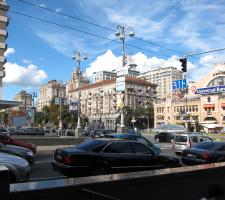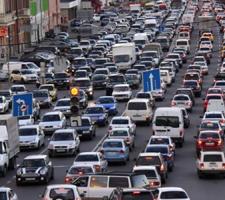
With increasing road fatalities the Ukrainian government is planning to introduce ITS technology in 2016-2017. Eugene Gerden finds out more.
The government of Ukraine is considering a massive introduction of ITS in the national system of traffic during the period 2016-2017, according to a recent statement by the Ukrainian Ministry of Transport.
According to the Ukrainian government, implementation of the project is an acute need, as in recent years the number of road accidents in Ukraine has significantly increased. In 2013 the accident total reached 191,005.
The figures for 2014 have not yet been announced, but, according to preliminary reports of the Ukrainian Federal Authority for Road Traffic Safety, they may be significantly higher than the results of 2013.
According to an official representative of the Kiev regional government, the number of cars has significantly increased by 30%, compared to in 2000 and ITS needs to be introduced to cope with the increase.
Factfile - Kiev, Ukraine
100-150,000
Cars enter Kiev each day
40-60 minutes
Average daily commute
191,005
road accidents in Ukraine in 2013...
...at a cost of US$200 million
Lack of modern ITS may result in traffic collapse in the city during the next several years, taking into account the ever growing level of motorisation in Ukraine, which is currently estimated at 250-270 cars per 1,000 citizens and which is expected to hit between 300 and 320/1,000 this year. At the same time, in the case of Kiev, these figures are expected to be significantly higher at between 400 and 420 cars/1,000.
The current situation with traffic control in Kiev and other large cities within the country remains complex. This is mainly due to the fact that the majority of local ITS such as traffic lights, electronic announcement boards or intelligent road signs and other means of traffic control were installed during the Soviet times and are completely outdated. According to data from the Ukrainian Ministry of Transport, up to 80% of the existing traffic lights in the country should be replaced during the next few years.
The systems that have been installed mainly focus on coordinated control of traffic and pedestrian flows on individual roads of the local cities. The individual systems were not connected with each other in any meaningful way although that is all set to change in the near future.
An initiative for the introduction of ITS in the Ukrainian system of traffic was first put forward by Leonid Chernovetsky, a former mayor of Kiev, in 2008. However, a lack of funds and the beginning of the global recession meant that implementation of the project was suspended.
Smart lights
According to an official spokesman of the Ukrainian Ministry of Transport, the revived project involves introduction of a new ITS system, which will be known as ‘Smart Lights’, a single system of traffic lights that will be operated synchronously. These will replace the old traffic lights in areas such as Khreshchatyk, the European Square and Bessarabska Square, and variable information boards will also be installed at the same time with road safety cameras deployed in key streets of the Ukraine’s largest cities including Kiev, Kharkov and Odessa.
There is also the possibility of similar installations in other cities in the coming few years.
At the same time the project also involves the design of several programs for traffic control including a single ITS control centre covering road, rail and metro.
In addition, the Ukrainian government plans to install sensors to monitor the vehicles in the state-run fleet as well as state-owned road building machinery and a significant part of public transport.
According to an official spokesperson of the Ukrainian Ministry of Transport, this will help to achieve significant savings on fuel and to increase the response rate of emergency and operational services including fire, police and ambulance. While this may see the arrival of emergency services on the scene in city centre streets in an estimated average of three minutes, in the case of other streets, the time of arrival is in the range of 15-20 minutes.
There are also plans to introduce adaptive traffic light systems that can adjust to the situation on the road, and prioritising areas with the most intensive traffic. This is one step beyond the ‘Smart Lights’ designed to keep the traffic moving and ensure non-stop traffic can adapt to a particular situation on the road, depending on the level of traffic density.
Finally, implementation of the project ‘Green Korridor’ involves the introduction of automated control for trucks. This will provide the Kiev authorities the ability to control trucks and other heavy transporters entering certain districts of Kiev covered by a blanket ban.
The World Health Organisation puts the economic consequences of road accidents globally at an estimated US$500 billion, while the losses for cities due to traffic jams is about 6-8% of their GDP. In the case of Ukraine, these figures are estimated at US$200 million and 10-12% respectively.
Total volume of investments in the project is not disclosed. However, according to some sources close to the Ukrainian Ministry of Transport, they may exceed UAH 1 billion (US$100 million) for a city with a population of 1 million people. There is a possibility that they will significantly increase after stabilisation of the current economic situation in Ukraine and the end of the military conflict in the eastern part of the country.
According to Dmitry Pankratov, an official spokesman of
Dmitry Pankratov comments: “Unlike road safety cameras, the system of traffic control which is planned for installation in the largest cities of Ukraine does not bring direct profits to the country’s budget. The introduction of the system will reduce travel times, as well as lower emissions and improve fuel economy - which primarily benefits drivers rather than the government. There will be no direct economic incentives for the country’s budget, as the annual proceeds from fines are not expected to cover even half of the state investments planned for the project. This may result in the decline of interest to the project from the Ukrainian government.”
It is planned that the majority of funds for the implementation of the project will be provided from the state budget, with the remainder coming from private investors, including foreign.
According to the plans of the Ukrainian government, part of the funds may be provided by the European Bank for Reconstruction and Development (EBRD), which has already invested about €1 billion over the last few years to fund road building in Ukraine.
There is also the possibility of using EU experience in the adoption of ITS on Ukrainian roads, in particular that of Germany, where a special public-private centre for traffic management operations has been recently established. The aim is to attract public-private funds for the projects in the field of ITS and roadbuilding.














